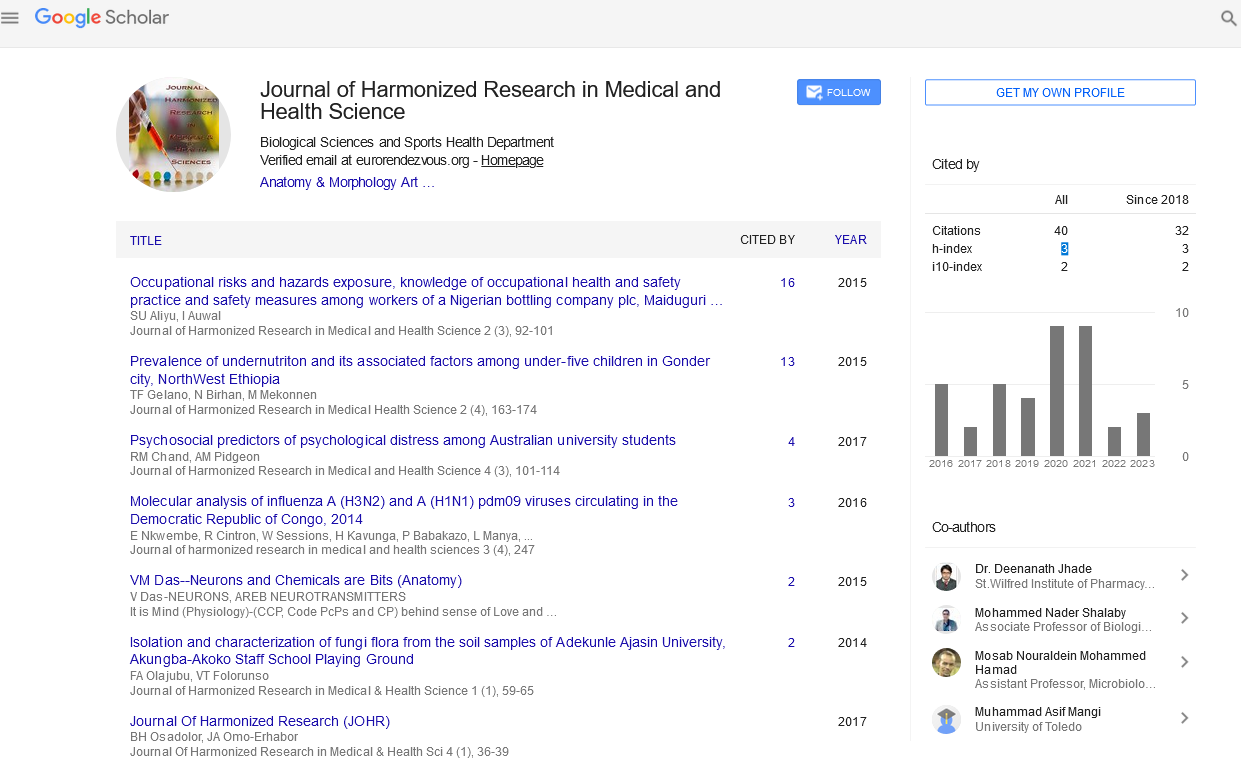Commentry - (2022) Volume 9, Issue 4
BIOLOGICAL MECHANICS OF EPIGENETICS AND CONNECTIONS TO GENETICS
Marco Russo*Received: Nov 01, 2022, Manuscript No. JHRMHS-22-83829; Editor assigned: Nov 04, 2022, Pre QC No. JHRMHS-22-83829 (PQ); Reviewed: Nov 24, 2022, QC No. JHRMHS-22-83829; Revised: Dec 02, 2022, Manuscript No. JHRMHS-22-83829 (R); Published: Dec 12, 2022, DOI: 10.30876/2395-6046.22.9.139
Description
Epigenetics offers the ability to fully explain a number of biological phenomena that up to now have eluded explanation. In a chronological epigenetic perspective, this overview discusses the numerous endogenous human developmental milestones, such as conception, puberty and menopause, as well as the various external environmental influences that affect human health. Describe the complete course of a person’s existence from preconception to defeat and list all possible internal time points and environmental influences on the human epigenome in chronological order. In the end, the environment exposes an individual to these numerous stimuli that affect the epigenome, and each person’s own epigenetic and genomic profile also modifies the particular response to these events. In the course of living a living thing, we are exposed to a powerful and dynamic environment that is capable of causing chemical changes that can either activate or quiet genes. For normal growth and maintenance of health as well as for determining disease burden and resistance, there is continuous communication between the internal and external environments. The epigenome, which includes any genetic expression modulator independent of a gene’s DNA sequence, is a collection of chemical tags that affect DNA and its related structures. The entire collection of genetic data found in each organism’s DNA and stored in its cells is known as the genome. The intricate alterations connected to genomic DNA, the other hand, make up the epigenome and give cells and developmental processes their own distinct identities. The reduction process in the genome is integrated with all of the chemical and chemical stimuli of intracellular, external and environmental origin via the epigenome. The epigenome, along with the genome, directs each cell type’s particular gene expression programmer to define its functioning identity throughout development or sickness. A flexible and dynamic response to both intra- and extracellular stimuli, by cell-cell contact, by surrounding cells, by biology, or wholly by the eco system that the animal is exposed to, distinguishes the epigenome from the genome’s consistency. Types of proteins that are modified by the environment and are classified as of epigenome modifiers include cytokines, growth factors, changes in hormone levels, as well as the release of strain and neurotropic factors. In the end, the environment exposes an individual to these numerous stimuli that affect the epigenome and each person’s own epigenetic and hereditary profile also modifies the particular response to these events. Given the stability of these directions, the terminal phenotype inside an organism is not fixed and divergence is produced by variations in gene expression in response to environmental signals. Each cell in the organism has an identical genome. The main mechanisms regulating these modifications include DNA methylation, histone modification and RNA-associated silencing. The chromosomal arrangement of methylated DNA sequences in a cell is known as the methylene and it can change depending on the environment or a cell’s stage of development. When DNA gets methylated, a methyl group, also known as 5-methyl C or CMe, is covalently added to the cytosine pyrimidine ring at position 5. The majority of mammalian protein-coding genes start their transcription at regions of the promoter known as CG sequences, where cytosine is situated adjacent to a guanine nucleotide linked by a phosphate and is known as a CpG site. CpG islands are the names given to these brief CpG-rich DNA segments.28 million CpG dinucleotide in the human genome 60%-80% of are the methylated. Active C’s in CpG islands are often methylated and DNA repair mechanisms convert methylated cytosine’s that spontaneously delaminate to uridine back to cytosine, maintaining CpG sequences throughout evolution. Because DNA methylation causes chromatin to condense, the absence or 5-methyl C in a CpG island indicates an inactive promoter. The primary protein building blocks of chromatin complexes, histones provide the structural framework around which DNA wraps to produce chromatin. The initial level of chromatin organization is represented by the nucleosome, which is made up of two of each histone H2A, H2B, H3, and H4 arranged in a possibly related core with DNA firmly around the octamer. Histones control how DNA is packaged and have a significant impact on how tightly chromatin is packed, which affects both transcriptional activity and transcriptional suppression. Small non-coding lengths of RNA, also known as microRNAs and interfering RNAs, can block or down regulate the transcription of one or more proteins during RNA-associated silencing, a type of article gene modification despite making up just 1% of the genome, microRNAs are thought to target 30% of genes. These RNAs can function as valves and modulators, having a significant impact both inside and outside of the cell. The unique modulators that these RNAs operate as in response to the cell-type specificity of the creature during growth as well as pathological situations fine-tune the gene expression.










